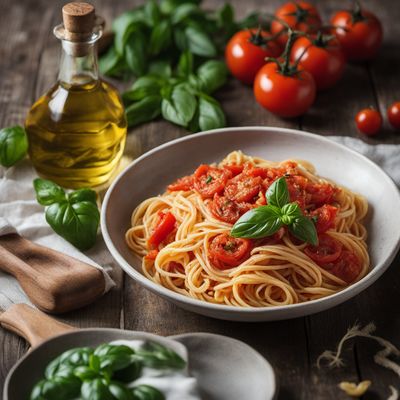
Ingredient
Cheese, monte veronese
The Italian Gem: Monte Veronese Cheese
Monte Veronese cheese is a semi-hard cheese with a pale yellow color and a smooth, creamy texture. It has a delicate, slightly nutty flavor with hints of sweetness. The cheese is often aged for different periods, resulting in varying intensities of flavor. It is commonly used in Italian cuisine, particularly in pasta dishes, risottos, and salads.
Origins and history
Monte Veronese cheese has a long history in the Veneto region of Italy, dating back to the Middle Ages. It is named after the Monte Veronese mountain range, where it was traditionally produced. The cheese is made from cow's milk and is known for its high quality and distinct flavor. It has been awarded Protected Designation of Origin (PDO) status, ensuring its authenticity and adherence to traditional production methods.
Nutritional information
Monte Veronese cheese is a good source of calcium, protein, and vitamins A and B12. It is also relatively low in fat compared to other cheeses. A 1-ounce serving of Monte Veronese cheese provides approximately 100 calories, 7 grams of protein, and 8 grams of fat.
Allergens
Monte Veronese cheese is made from cow's milk, so individuals with lactose intolerance or milk allergies should avoid it. It is also not suitable for those following a vegan or dairy-free diet.
How to select
When selecting Monte Veronese cheese, look for ones that have a smooth, unblemished rind. The cheese should feel firm to the touch but still have a slight give. Avoid cheeses with any signs of mold or excessive moisture. It is best to purchase Monte Veronese cheese from reputable cheese shops or specialty stores that offer a wide selection of high-quality cheeses.
Storage recommendations
Monte Veronese cheese should be stored in the refrigerator to maintain its freshness. Keep it wrapped in wax paper or cheese paper to allow it to breathe. Avoid storing it in plastic wrap, as this can cause the cheese to sweat and develop off-flavors. Bring the cheese to room temperature before serving to enhance its flavors.
How to produce
Monte Veronese cheese is typically produced by professional cheesemakers using traditional methods. It requires specific equipment and expertise to ensure the cheese develops its characteristic flavor and texture. However, individuals can try making fresh cheese at home using cow's milk and a cheese-making kit.
Preparation tips
Monte Veronese cheese can be enjoyed on its own or incorporated into various dishes. It melts beautifully, making it ideal for pasta dishes, risottos, and gratins. It can also be used in salads or served alongside fresh fruits and nuts. Pair it with a glass of Italian red wine for a complete culinary experience.
Culinary uses
Monte Veronese cheese is commonly used in Italian cuisine, particularly in the Veneto region. It is often grated over pasta dishes, such as gnocchi or risotto, to add a rich, creamy flavor. The cheese can also be enjoyed on a cheese board or used in sandwiches and paninis. Its versatility makes it a staple in many Italian households.
Availability
Italy
More ingredients from this category » Browse all

Cheese, hoch ybrig
The Alpine Delight: Unveiling the Richness of Hoch Ybrig Cheese

Cheese, coolea
Coolea Cheese: A Taste of Irish Craftsmanship

Cheese, samsoe
The Savory Delight: Unveiling the Secrets of Samsoe Cheese

Cheese, pecorino toscano
The Quintessential Tuscan Cheese: Pecorino Toscano

Cheese, emmental
The King of Swiss Cheeses

Cheese, leyden
The Dutch Delight: Unveiling the Savory Secrets of Leyden Cheese

Cheese, evora
Evora: A Portuguese Delight

Cheese, canestrato pugliese
Canestrato Pugliese: A Taste of Puglia's Rich Cheese Heritage

Cheese, montasio
The Alpine Delight: Exploring the Richness of Montasio Cheese

Cheese, idiazabal
The Basque Treasure

Cheese, murcia
The Tangy Delight: Murcia Cheese

Cheese, gruyere
Gruyere: The Quintessential Swiss Cheese
Recipes using Cheese, monte veronese

Montenegrin-style Scialatielli alla Sorrentina
Savory Montenegrin Twist on Scialatielli alla Sorrentina

Refreshing Jellyfish Salad
Ocean Delight: A Vibrant Jellyfish Salad

Chifa-style Jellyfish Salad
Oceanic Fusion: Chifa-style Jellyfish Salad

Chinese-style Jellyfish Salad
Tangy and Refreshing Jellyfish Salad with a Chinese Twist